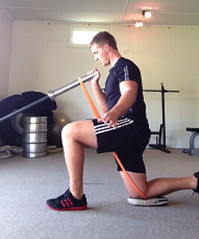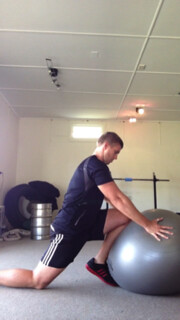When I first moved to Boston – roughly seven years ago – I was working at a swanky, fancy-pants commercial gym in the downtown area and I remember on one of my days off Eric Cressey and myself took a little road trip to Worcester, MA to take part in an impromptu and informal workshop that orthopedic surgeon, Dr. Chris Vinton, was doing at the College of the Holy Cross on Femoral Acetabular Impingement (FAI).
Like some of you seeing this for the first time and starring at the screen as if I were saying the alphabet in Klingon, at the time of Dr. Vinton’s talk I had a similar reaction: Femoral Acetabular Say-What-Now???
Without beating around the bush, in laymen’s terms: “FAI is a condition of too much friction in the hip joint. Basically, the ball (femoral head) and socket (acetabulum) rub abnormally creating damage to the hip joint. The damage can occur to the articular cartilage (smooth white surface of the ball or socket) or the labral cartilage (soft tissue bumper of the socket).”
Resultantly it sucks donkey balls.
Source: www.hipfai.com (except for that last sentence).
FAI comes in a few flavors. You have your Cam form which manifests itself as a bony overgrowth on the femoral head itself, and you have your Pincer form which results from a bony overgrowth on the rim of the acetabulum itself. And lastly, for those unfortunate few who can’t seem to make up their mind, you can also have a Mixed form which is a bony overgrowth of the two.
Even then, seven years ago, as I was sitting through the presentation, FAI wasn’t that prevalent in the athletic or fitness community – or, so it seemed. I couldn’t recall one case of a current or past client who I felt fell under this FAI tree.
Fast forward to today and it seems everyone has FAI. Hockey players, baseball players, soccer players, the mailman, the woman who does your hair, Batman. Everyone.
Of Note: Eric was talking the other day about this and mentioned something about a recent study that came out which showed something like 90% plus of high school hockey players have some degree of FAI.
I’ll have to see if I can ask him to find the study. Stay tuned……
UPDATE: Kevin Neeld discusses it HERE.
I don’t feel it’s because of some new pandemic or anything – like we’ve somehow mutated into a bunch of hip impingement ninjas. Nah – nothing like that.
Well, maybe a little bit. If I were speak freely I do feel that athletes today – particularly young athletes – fall into two categories:
1. Those who specialize too early and play ONE sport year round without any breaks. It’s not rocket science to see how someone who plays a rotational sport year round, and develops pattern overload, can run into problems.
2. Those who make the Tin Man look agile. It’s sad to say, but kids (and adults) just don’t move around as much anymore. Texting has taken the place of riding a bike. Call of Duty has trumped pick-up baseball games. Escalators > stairs.
So I think we have ourselves to blame…..to a degree. When we take people who have joint restrictions and don’t move well, and then ask them to “do stuff” they aren’t prepared to do. Well…….
But too, I just feel we’ve gotten a heckuva lot better in recent years at screening for FAI and recognizing symptoms.
Before I go on I should state the obvious: as a strength coach I’m not diagnosing anything. I can use some rudimentary “screens” (like the one to follow) which will better help me ascertain the situation and provide information on how I’ll go about programming for someone. But almost always, I’ll be referring someone out to a more qualified fitness professional who can do a more thorough exam and/or possibly order an MRI.
That said if I’m working with an athlete or general population client who’s complaining of consistent and chronic hip pain – especially if they participate in a rotational sport or when squatting, I can do a quick “screen” as follows.
Here, I lie the person on their back and make sure their lumbar spine is flush against the table. Then I’ll bring the affected limb into flexion, adduction, and internal rotation.
If the person winces or punches you in the face, it’s fair to say that that lit them up, and they may be a candidate for FAI. You can tweak the test by having them brace their abs – which will encourage more posterior pelvic tilt – and if it feels better, you know that’s it’s more of an alignment issue and not a worse case scenario.
No need to send someone for an MRI when all they had to do was posteriorly tilt their pelvis.
But it stands to reason that even with their anterior core engaged, if that still causes discomfort, it’s time to refer out and get them to see a more qualified practitioner to dig a little deeper. Only through a combination of screens, tests, and possibly an X-ray or MRI can FAI be truly diagnosed.
But What Can You Do In the Meantime?
A lot, actually. But lets try not to get carried away in thinking we’re going to solve the issue. This is more about working AROUND the issue and maintaining a training effect than anything else.
FAI is a condition, not a disease. But here’s some food for thought.
1. Rule numero uno is to nix squatting. You’re not going to last long as a strength coach or personal trainer if you’re throwing caution to the wind and squatting those who are candidates for FAI.
I will say, though, that I say that with a grain of salt because technically you could still squat someone – albeit NOT BELOW 90 DEGREES OF HIP FLEXION.
If you look at the pictures provided above of the Cam and Pincer lesions, you can see how if someone were to squat below 90 degrees, that that would be, well, dumb.
Depending on symptoms you could get away with staying above 90 degrees, but honestly my rule of thumb is to wait six months before playing with fire.
2. The good news is that you can still hit the lower body fairly hard. Things like rack pulls, trap bar deadlifts, or even conventional deadlifts would be fair game given that neither require significant hip flexion. In addition barbell glute bridges would be a viable option as well.
3. Surprisingly, single leg work is fair game. Even things like Bulgarian split squats – as counterintuitive as it sounds given they require deep hip flexion – would be okay.
The thing with single leg work is that the trainee can sort of find his or her “groove” with regards to hip internal and external rotation and be able to find a pain free ROM.
To that end I wouldn’t be apprehensive to crush single-leg training with someone with FAI – although certain things like femoral glide syndrome should be on the radar and may lend itself to making appropriate modifications.
4. Go read anything and everything by Kevin Neeld on the topic. THIS and THIS would be good starts.
And that’s about it really. I think as strength coaches and personal trainers it IS in our best interests to know when to refer out and understand scope of practice. But just as equally (if not more) important is to have the ability to assess and screen clients for certain conditions and be able to still garner a training effect and not make them feel like a patient.
Of course there is still a lot that’s unknown about FAI (s0me doctors still fail to admit that it exists!), and this post isn’t meant to serve as a definitive path to address the issue. If anything I just wanted to throw it out there and hopefully bring forth a little more awareness on the topic.





 There are times when being couch or bed ridden is unavoidable. Although when you are able to be up and moving around, there is then also the chance to begin to start the process in moving forward.
There are times when being couch or bed ridden is unavoidable. Although when you are able to be up and moving around, there is then also the chance to begin to start the process in moving forward.

